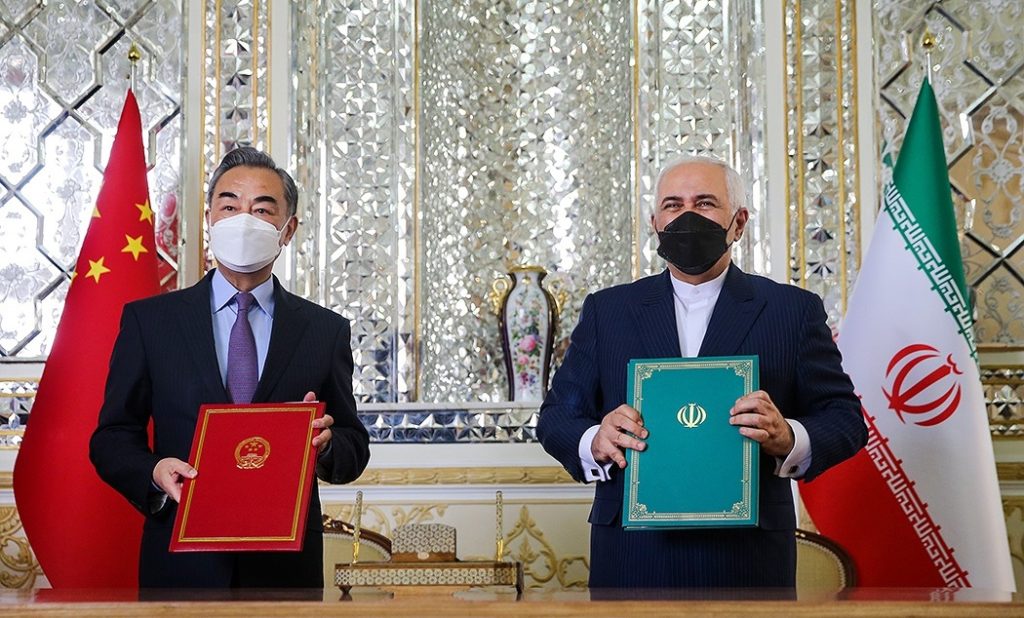March 26, 2021

Iran and China signed a 25-year strategic cooperation agreement March 27, but neither government revealed any of the contents of the pact, which has become very controversial in Iran.
The deal provides for China to invest heavily in Iran in projects that spread all over the economy. The controversy is over what concessions the Islamic Republic has made to China to attract such investments.
China is infamous for proposing deals that lock countries into a disadvantageous economic position. Its most infamous deal was with Sri Lanka; that deal left China with ownership of significant infrastructure on the island when the Sri Lankan government couldn’t fulfill its side of the agreement.
Iran agreed to negotiate a “strategic cooperation pact” in January 2016 when Chinese President Xi Jinping visited Tehran. But that was the month the Joint Comprehensive Plan of Action (JCPOA) took effect and European investors started pouring into Tehran, aborting Iranian interest in China.
Little came of the European investor visits, however. And when President Donald Trump withdrew from the JCPOA in May 2018, everything started moving backward for Tehran. The Islamic Republic then revived its interest in a deal with China. Supreme Leader Ali Khamenehi called for deeper relations with “trustworthy, independent countries like China.”
But many Iranians feared Iran would be taken advantage of by the crafty Chinese, just as they felt it was taken advantage of by the crafty British and the crafty Americans in the 19th and 20th centuries.
Last July, an 18-page document that purported to be a draft of the agreement with China was leaked. It had Iran selling oil to China at a huge one-third discount and spoke of Chinese troops being deployed in Iran to protect Chinese construction projects. Both seemed highly unlikely to many professional analysts, who saw the leaked document as a fake.
Foreign Minister Moham-mad-Javad Zarif was heckled in the Majlis when he asserted there was “nothing secret” in the proposed deal and that the full contents would be revealed “once it has been finalized.” It has now been finalized. But Iran only announced generalities such as, “The document focuses on the capacities and perspectives for bilateral cooperation between the two countries in various areas, including economic and cultural fields, among others.” That was the sole sentence of substance in the four-paragraph statement issued in English by the Foreign Ministry.
The deal marks the first time Iran has signed such an agreement with a major world power. The deal comes on the 50th anniversary of the establishment of diplomatic relations between China and Iran.
Reportedly, Iran and China have done some $20 billion in trade annually in recent years. That’s down from nearly $52 billion in 2014, however, because of a decline in oil prices and US sanctions.
And no one said how sanctions would impact the new agreement. Oddly, the same day the agreement was signed, Shana, the Oil Ministry’s news website, carried a very long (for it) story saying China was reneging on its 2008 agreement to develop the Yadavaran oilfield in Khuzestan province.
Shana said China’s Sinopec oil firm completed the first phase of Yadavaran development in November 2016. It said, “Sinopec was required to go ahead with the second phase development. However, the Chinese refused to do so for a variety of reasons, including sanctions…. The Chinese company has not provided any plans,” and suggested that Iran should continue on its own, although Phase 2 requires $2 billion in investment.
It was curious timing; the story may have been intended to stir China into action. But it also exposed disinterest in Iran by one of China’s biggest corporations.
Last year, the Supreme Leader named Ali Larijani, a former Majlis speaker, as his special representative for strategic ties with China. Larijani appears to have had a major role in drafting the deal. It is unclear if the Foreign Ministry had an equal role, although the document was signed by Zarif and his Chinese counterpart, Wang Yi, while Wang was visiting Tehran.
Ahead of the signing, Wang said, ”Iran decides independently on its relations with other countries and is not like some countries that change their position with one phone call.”
But Wang didn’t come to the region just for the Iran signing. He was on a two-week, five-nation tour. He visited Iran’s rivals, Saudi Arabia and Turkey, before arriving in Tehran. Some suspected he visited those countries to try to assuage any concerns they might have about the deal. After Tehran, he went to the UAE, Bahrain and Oman.
